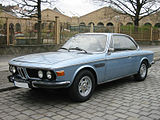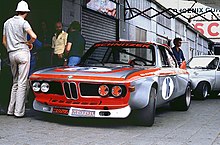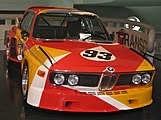BMW E9
| BMW | |
|---|---|
|
BMW 3.0 CSi
|
|
| E9 | |
| Sales designation: | E9 coupe |
| Production period: | 1968-1975 |
| Class : | Upper class |
| Body versions : | Coupe |
| Engines: |
Petrol engines : 2.5-3.2 liters (110-151 kW) |
| Length: | 4661 mm |
| Width: | 1648 mm |
| Height: | 1369 mm |
| Wheelbase : | 2624 mm |
| Empty weight : | 1165-1420 kg |
| Previous model | BMW 2000 Coupe |
| successor | 6 series (E24) |
The BMW E9 is the coupé variant of the E3 series . The vehicles were built between December 1968 and December 1975 on behalf of BMW at Karmann 's Rheine plant. A total of 30,546 cars were built. The range exclusively comprised six-cylinder in - line engines with a displacement between 2.5 and 3.2 liters and an output of 110 to 151 kW (150 to 206 hp).
The E9 complemented the BMW Coupé 2000 C / CA / CS of the "New Class" built from 1965 . The successor to the E9 was the first 6 series ( E24 ) in 1976 .
Model history
From 1968 to April 1971, only the BMW 2800 CS with a 2.8-liter carburettor engine with 125 kW (170 hp) was available. A total of 9,399 examples of the BMW 2800 CS were built. In April 1971 this model was replaced by the 3.0 CS (also with a carburettor engine, 132 kW (180 PS)), which was built 10,898 times by the end of production in December 1975. Both vehicles were also available with a three-speed automatic transmission from ZF (internal designation BMW 2800 CSA or BMW 3.0 CSA).
In the fall of 1971 came as a further model variant of the BMW 3.0 CSi with Bosch D-Jetronic - manifold injection added that is otherwise identical to the BMW 3.0 CS. This model has 147 kW (200 PS), accelerates from 0 to 100 km / h in 7.7 seconds and reaches a top speed of 220 km / h. 8,144 vehicles were built up to the production stop in November 1975.
The BMW 2.5 CS was built 844 times between 1974 and 1975. The 110 kW (150 hp) two-and-a-half-liter was the entry-level model and could only be distinguished from the large three-liter models by the missing bumper horns and the lettering. With a manual transmission, the vehicle accelerates to 100 km / h in 9.9 seconds, and the top speed was reached at 200 km / h.
- BMW 3.0 CS Automatic (1971-1975)
BMW 3.0 CSL


From 1971 onwards, the first 3.0 CSL Coupés were produced in collaboration with Alpina as a homologation series for touring car racing , in which BMW was very successful with the BMW 02 at the time . The name CSL (Coupé Sport Leichtbau) was program, as the lightweight coupés did not receive any performance increase compared to the BMW 3.0 CS, but thanks to weight-saving measures (including rear windows made of Plexiglas; engine hood and doors made of aluminum) weighed 1165 kg empty and in 7, Accelerated to 100 km / h in 4 seconds. 169 of these vehicles were built.
From August 1972 the D-Jetronic intake manifold injection was also used in the BMW 3.0 CSL. Despite the slightly increased displacement compared to the BMW 3.0 CSi (3003 instead of 2985 cm³), these vehicles also produce 147 kW (200 hp) and reach 220 km / h, but accelerate from 0 to 100 km / h in just 6.9 seconds. Of this second production run of the BMW 3.0 CSL, a total of 939 examples were made by August 1973, 500 of them with right-hand drive.
The third and final stage of the BMW 3.0 CSL (July 1973 to November 1975) produced 152 kW (206 hp) from 3,153 cc. It owes its nickname " Batmobile " to an extensive aerodynamics package, in particular the huge rear wing, which was stowed away in the trunk of the vehicle due to the lack of road approval. The then BMW racing driver Hans-Joachim Stuck was asked at a petrol station when he was out and about with his “Dienst-CSL” whether this rear wing was “a new ski holder”.
The BMW 3.0 CSL is the first product of what later became BMW Motorsport GmbH , at that time still a division of BMW, and can therefore be described as the very first “M” -BMW. The car also had the colors of the later M-GmbH.
With the appearance of the first 6-series from BMW (E24 series) in 1976, the CSL racing cars had no factory support. And even if the relatively heavy successor model was very successful, the CSL successes of private teams initially put the light of the 6er in the shade when Alpina won the European championship title with Dieter Quester in 1977. Even in 1978 the E9 was still not beaten when Umberto Grano won the championship in a Luigi-CSL.
The E9-CSL coupes were among others a. also in tuned versions of GS-Tuning (169 kW with carburetor), Alpina (184 kW with intake manifold injection ), Koepchen (191 kW with carburetor) and Schnitzer (213 kW with intake manifold injection).
Models and technical data
The BMW E9 was equipped exclusively with six-cylinder in - line engines from the M30 series , which were also used in the E3 sedan . There were also prototypes with eight- and twelve-cylinder engines that had already been developed . However, in view of the impending oil crisis, these were not implemented. It is worth mentioning here that BMW development chief Bernhard Osswald used a green BMW 3.0 CSi with a five-liter V8 cylinder of around 206 kW (280 hp) as a company car in 1973. 250 km / h were possible with this vehicle. But it remained a unique piece.
The motor data of the individual model variants in a table overview:
| model | Displacement | power | Max. Torque at 1 / min | Production period |
|---|---|---|---|---|
| 2.5 CS | 2492 cm 3 | 110 kW (150 PS ) | 211 Nm at 3700 | 1974-1975 |
| 2800 CS | 2788 cm 3 | 125 kW (170 hp) | 235 Nm at 3700 | 1968-1971 |
| 3.0 CS | 2985 cm 3 | 132 kW (180 PS) | 255 Nm at 3700 | 1971-1975 |
| 3.0 CSi | 2985 cm 3 | 147 kW (200 hp) | 272 Nm at 4300 | 1971-1975 |
| 3.0 CSL | 2985 cm 3 | 132 kW (180 PS) | 255 Nm at 3700 | 1971-1972 |
| 3.0 CSL | 3003 cm 3 | 147 kW (200 hp) | 272 Nm at 4300 | 1972-1973 |
| 3.0 CSL | 3153 cm 3 | 151 kW (206 hp) | 286 Nm at 4300 | 1973-1975 |
Special bodies
In 1969 three 2800 CS with stainless steel body were realized with DEW - Deutsche Edelstahl AG, Krefeld. The stainless steel body project - so-called Remanit, a standard steel that was processed with series tools - was carried out by BMW. One of these vehicles was tested over 125,000 km.
Since 1970 there have been various conversions to convertible cars. Only in 2004 did BMW offer a convertible of the large coupé itself, namely the revived 6 Series E63 / E64 .
Racing versions

The racing version of E9-CSL made in 1974 by displacement magnification to 3498 cm 3 and a four-valve cylinder head 324 kW (440 hp) at 8500 min -1 , accelerated in 4.0 seconds from 0 to 100 km / h, and reached a maximum speed of 275 km / H. In the 1976 racing season, Group 5 rules were introduced in the brand world championship , which allowed many changes compared to the production vehicles. The almost 440 kW Porsche 935 won four of the seven races and also the world championship; however, the BMW Coupés won three races despite the many turbo- Porsche 934s in customer hands and thus kept the championship open until the last run.
The BMW works team also competed in a few races: using four-valve technology and turbocharging, the car achieved an engine performance that had previously only been achieved by the turbo engine of the Porsche 917/10 , and that in Formula 1 only in the turbo era 1980s should be possible: up to 590 kW. Due to the enormous torque that was generated, the load limit of the Getrag five-speed transmission was exceeded, and the power could hardly be brought to the ground: 0-100 km / h in 3.5 seconds and a top speed of 308 km / h. With this kind of engine power, the top speed was limited in terms of speed and driving resistance due to the lack of a suitably adapted six-speed gearbox: full throttle passages on long straights would have destroyed the engine of the racing CSL with overspeed. The Swedish racing driver Ronnie Peterson is said to have spun at a speed of over 250 km / h when accelerating, which is why one set of tires only lasted 64 km. The turbo-BMW achieved the second-best practice time in its first outing at Silverstone , but only reappeared at the all-important final race in Dijon , this time taking first place on the grid in front of the works Porsche. The six-cylinder turbo was eliminated early on; BMW limited itself to supercharging the small M10 four-cylinder and developed this successfully in the years that followed up to the F1 World Championship in 1983.
BMW 3.0 CSL Art Cars
A BMW 3.0 CSL became the first BMW Art Car in 1975 . Based on the initiative of the French auctioneer and racing driver Hervé Poulain, the American artist Alexander Calder painted a racing car based on a BMW 3.0 CSL. Hervé Poulain drove this car together with Sam Posey and Jean Guichet in the 1975 Le Mans 24-hour race . The work of art with black lines, created the following year by New Yorker Frank Stella, also based on a BMW 3.0 CSL, started at the 24 Hours of Le Mans in 1976 .
The BMW Art Car designed by Alexander Calder was driven at Le Mans by Hervé Poulain , Sam Posey and Jean Guichet .
The BMW Art Car designed by Frank Stella was number 41 at the 1976 Le Mans 24-hour race and was driven by Brian Redman and Peter Gregg .
BMW 3.0 CSL homage
In 2015, BMW presented a 3.0 CSL homage at the Concorso d'Eleganza on Lake Como. Their color took on the yellow tone "Golf" in which the original 3.0 CSL was available. In 2016, BMW then showed the CSL homage in the motorsport colors.
literature
- Andrew Noakes: Fascination BMW . 1st edition. Parragon, Bath 2006, ISBN 1-4054-5515-2 (English: The Ultimate History of BMW . Translated by Gina Beitscher).
Web links
- BMW Coupé Club e. V., Community for the receipt of the E9 accessed July 2, 2017.
- E9 Production & VIN Numbers. e9-driven.com, accessed on May 2, 2013 (English).
- E9 forum | for the BMW CS Coupé types BMW 2800 CS, 3.0 CS, 3.0 CSi, 3.0 CSL and 2.5 CS built between 1968 and the end of 1975. (German)
Individual evidence
- ↑ BMW 3.0 CSL. bmw-motorsport.com, archived from the original on May 12, 2010 ; Retrieved May 2, 2013 .
- ^ Ingo Seiff: BMW. Fascination from technology and design . Heyne, Munich 1990, ISBN 3-453-04360-X .
- ↑ The five muscled animals. Test BMW 3.0 CSL series and tuning . In: Auto, Motor und Sport . No. November 24 , 1972, ISSN 0005-0806 .
- ↑ Hanns-Peter Rosellen : The white-blue miracle. BMW - history and types . Seewald, Stuttgart 1983, ISBN 3-512-00650-7 .
- ↑ E9 with stainless steel body, BMW Group Archive , accessed July 2, 2017
- ↑ Information on the E9 stainless steel body under special coupés at BMW Coupé-Club e. V. , accessed July 2, 2017
- ^ E9 forum on convertible conversions from March / April 2011 , accessed July 2, 2017
- ↑ Welcome Home BMW Art Cars. (No longer available online.) BMW Museum, archived from the original on August 15, 2012 ; Retrieved June 24, 2013 . Info: The archive link was inserted automatically and has not yet been checked. Please check the original and archive link according to the instructions and then remove this notice.
- ↑ BMW Art Cars at Le Mans. maisonblanche.co.uk, accessed on June 24, 2013 (English, overview of the BMW Art Cars that started in Le Mans).
- ↑ Report on the 3.0 CSL Hommage at www.bimmertoday.de May 22, 2015. Retrieved July 5, 2017 .
| Timeline of the glass series models from 1955 to 1969 | |||||||||||||||||||||
|---|---|---|---|---|---|---|---|---|---|---|---|---|---|---|---|---|---|---|---|---|---|
| Type | independent (Hans Glas GmbH) | BMW | |||||||||||||||||||
| 1950s | 1960s | 1970s | |||||||||||||||||||
| 5 | 6th | 7th | 8th | 9 | 0 | 1 | 2 | 3 | 4th | 5 | 6th | 7th | 8th | 9 | 0 | 1 | 2 | 3 | 4th | ||
| Microcar | Goggomobil T | ||||||||||||||||||||
| Small car | Isar ("large Goggomobil") | ||||||||||||||||||||
| Lower middle class | 1004, 1204, 1304 | ||||||||||||||||||||
| Middle class | 1700 | 1800 SA, 2000 SA / 1804, 2004 [1] | |||||||||||||||||||
| Coupe | Goggomobil TS | ||||||||||||||||||||
| 1300 GT, 1700 GT | 1600 GT [2] | ||||||||||||||||||||
| 2600 V8, 3000 V8 | 3000 V8 [3] | ||||||||||||||||||||
| Vans | Goggomobil TL | ||||||||||||||||||||
|
|
|||||||||||||||||||||














